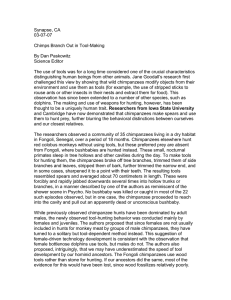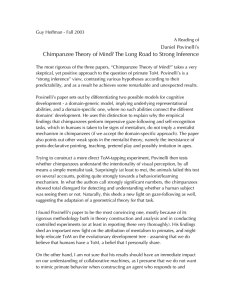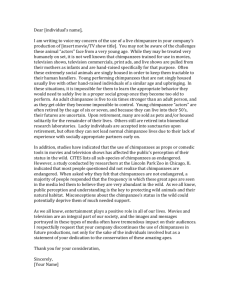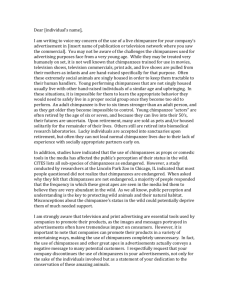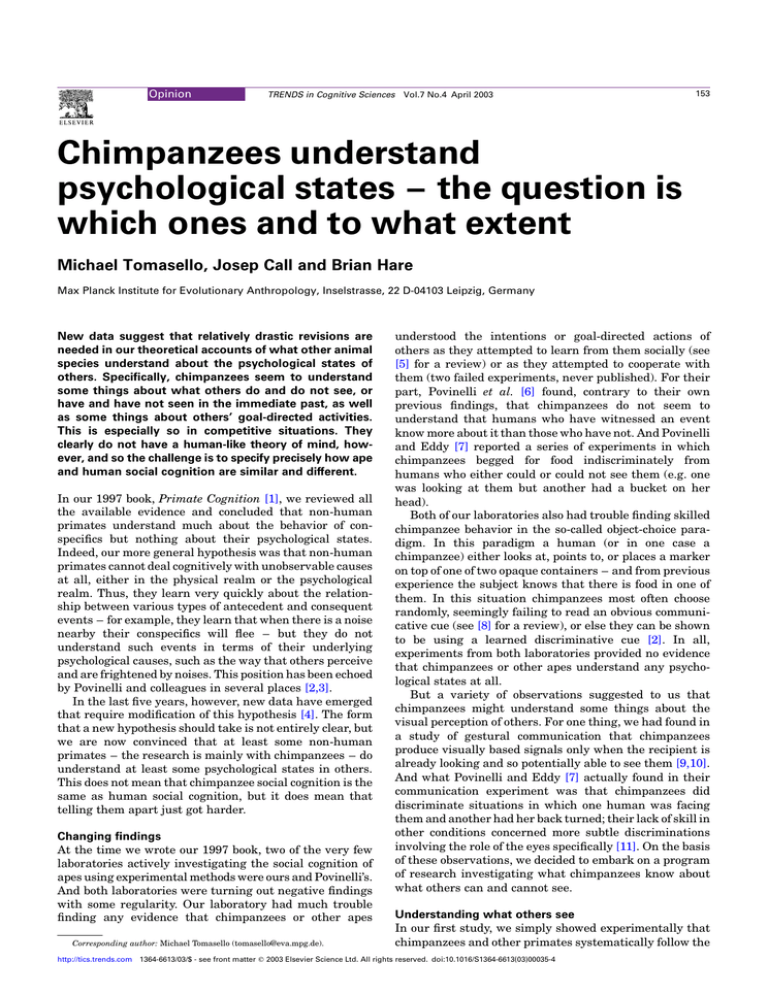
Opinion
TRENDS in Cognitive Sciences
Vol.7 No.4 April 2003
153
Chimpanzees understand
psychological states – the question is
which ones and to what extent
Michael Tomasello, Josep Call and Brian Hare
Max Planck Institute for Evolutionary Anthropology, Inselstrasse, 22 D-04103 Leipzig, Germany
New data suggest that relatively drastic revisions are
needed in our theoretical accounts of what other animal
species understand about the psychological states of
others. Specifically, chimpanzees seem to understand
some things about what others do and do not see, or
have and have not seen in the immediate past, as well
as some things about others’ goal-directed activities.
This is especially so in competitive situations. They
clearly do not have a human-like theory of mind, however, and so the challenge is to specify precisely how ape
and human social cognition are similar and different.
In our 1997 book, Primate Cognition [1], we reviewed all
the available evidence and concluded that non-human
primates understand much about the behavior of conspecifics but nothing about their psychological states.
Indeed, our more general hypothesis was that non-human
primates cannot deal cognitively with unobservable causes
at all, either in the physical realm or the psychological
realm. Thus, they learn very quickly about the relationship between various types of antecedent and consequent
events – for example, they learn that when there is a noise
nearby their conspecifics will flee – but they do not
understand such events in terms of their underlying
psychological causes, such as the way that others perceive
and are frightened by noises. This position has been echoed
by Povinelli and colleagues in several places [2,3].
In the last five years, however, new data have emerged
that require modification of this hypothesis [4]. The form
that a new hypothesis should take is not entirely clear, but
we are now convinced that at least some non-human
primates – the research is mainly with chimpanzees – do
understand at least some psychological states in others.
This does not mean that chimpanzee social cognition is the
same as human social cognition, but it does mean that
telling them apart just got harder.
Changing findings
At the time we wrote our 1997 book, two of the very few
laboratories actively investigating the social cognition of
apes using experimental methods were ours and Povinelli’s.
And both laboratories were turning out negative findings
with some regularity. Our laboratory had much trouble
finding any evidence that chimpanzees or other apes
Corresponding author: Michael Tomasello (tomasello@eva.mpg.de).
understood the intentions or goal-directed actions of
others as they attempted to learn from them socially (see
[5] for a review) or as they attempted to cooperate with
them (two failed experiments, never published). For their
part, Povinelli et al. [6] found, contrary to their own
previous findings, that chimpanzees do not seem to
understand that humans who have witnessed an event
know more about it than those who have not. And Povinelli
and Eddy [7] reported a series of experiments in which
chimpanzees begged for food indiscriminately from
humans who either could or could not see them (e.g. one
was looking at them but another had a bucket on her
head).
Both of our laboratories also had trouble finding skilled
chimpanzee behavior in the so-called object-choice paradigm. In this paradigm a human (or in one case a
chimpanzee) either looks at, points to, or places a marker
on top of one of two opaque containers – and from previous
experience the subject knows that there is food in one of
them. In this situation chimpanzees most often choose
randomly, seemingly failing to read an obvious communicative cue (see [8] for a review), or else they can be shown
to be using a learned discriminative cue [2]. In all,
experiments from both laboratories provided no evidence
that chimpanzees or other apes understand any psychological states at all.
But a variety of observations suggested to us that
chimpanzees might understand some things about the
visual perception of others. For one thing, we had found in
a study of gestural communication that chimpanzees
produce visually based signals only when the recipient is
already looking and so potentially able to see them [9,10].
And what Povinelli and Eddy [7] actually found in their
communication experiment was that chimpanzees did
discriminate situations in which one human was facing
them and another had her back turned; their lack of skill in
other conditions concerned more subtle discriminations
involving the role of the eyes specifically [11]. On the basis
of these observations, we decided to embark on a program
of research investigating what chimpanzees know about
what others can and cannot see.
Understanding what others see
In our first study, we simply showed experimentally that
chimpanzees and other primates systematically follow the
http://tics.trends.com 1364-6613/03/$ - see front matter q 2003 Elsevier Science Ltd. All rights reserved. doi:10.1016/S1364-6613(03)00035-4
Opinion
154
TRENDS in Cognitive Sciences
Fig. 1. Pan troglodytes or common chimpanzee.
gaze direction of conspecifics [12] (Fig. 1). But this
behavior could simply reflect a tendency to look in the
direction others are looking, and then to search randomly
for something interesting – with no understanding of
specifically where the other is looking. In a follow-up study,
therefore, a human looked behind a barrier, down into a
gutter, or into an adjoining room, to see if chimpanzees
would move so as to obtain a good viewing angle on the
specific target the human was looking at [13]. They did. In
another study, chimpanzees even looked back to the
experimenter if they followed his gaze direction and
found nothing there [14]. But it is still possible that
these studies demonstrate only that chimpanzees look to
Vol.7 No.4 April 2003
specific locations that others are looking at – so-called
geometric gaze following – without understanding anything about the content of what others are seeing
(i.e. without a mentalistic interpretation).
Then came our breakthrough experiments. In the first
set of studies we put a subordinate and a dominant
chimpanzee in competition over food (see Box 1). The trick
was that sometimes the subordinate could see a piece of
food that the dominant could not see due to a physical
barrier of some sort. The general finding was that
subordinates took advantage of this situation in very
flexible ways – by avoiding the food the dominant could see
and instead pursuing the food she could not see (and even
showing a knowledge that transparent barriers do not
block visual access). In the second set of studies (see Box 2)
a subordinate watched a human place food on her side of a
barrier and also observed whether or not the dominant had
watched the hiding process (the dominant’s door was
either open or closed during the hiding). When released to
compete for the food, subordinates seemed to know
whether the dominant had just witnessed the hiding
process a moment before. That is, when her door was
opened the subordinate avoided the food the dominant had
seen being hidden (even though the dominant could not see
it now) and instead pursued the food the dominant had
not seen being hidden (also not currently visible to the
dominant) – anticipating her competitive behavior on the
basis of her presumed visual experience some moments
before. And subordinates attached this knowledge not just
to dominants in general, but to specific individuals (see
control condition described in Box 2).
Recently, Povinelli and Giambrone [3] have offered a
different explanation for the first set of experiments. They
suggested that subordinates might simply prefer food next
to barriers over food out in the open, without monitoring
the dominant’s perceptual access at all. We ran a control
condition with subordinates in a non-competitive situation, and they did not prefer food next to barriers. But still
it is possible that in competitive situations they do have
Box 1. Knowing what others see
A dominant and a subordinate chimpanzee compete for food, with only
the subordinate having information about the location of the second
piece of food [23] (Fig. I).
Method: Subordinate (S) and Dominant (D) chimpanzee in rooms on
opposite sides of a middle room, each looking under cracked guillotine
door to see food (F) and each other. S and D released into middle room,
with S given a brief head start.
Main experiment: S and D see one F in open and only S sees other F on
her side of barrier.
Result: S goes for F on her side of barrier more than F in open.
Interpretation: S knows what D can and cannot see.
Alternative hypotheses and control conditions
(1)
Subordinate
Dominant
(2)
(3)
TRENDS in Cognitive Sciences
Fig. I. Experimental set-up in the food-competition experiments. Reproduced
with permission from Ref. [4].
http://tics.trends.com
(4)
S is reacting to D’s behavior. But S has a head start and so is forced
to choose before D’s door is opened.
D looks under door at F in open and intimidate S. But sometimes
D’s door is down when S makes her choice and so intimidation is
not possible.
S prefers F next to a barrier. But when S is given a choice of F in
open or F on her side of a barrier in non-competitive situations, no
preference.
S thinks barrier impedes D in getting F. But when F is on S’s side of
a transparent barrier, S stays away from it.
Opinion
TRENDS in Cognitive Sciences
155
Vol.7 No.4 April 2003
Box 2. Knowing what others know
A dominant and a subordinate chimpanzee compete for food, with
either one or both of them (in different experimental conditions)
observing the hiding process [24] (Fig. I).
Method: same as in Box 1 except that there are two barriers and one F
(on S’s side of one barrier).
Main experiment: (a) Control condition: S and D watch hiding
process; (b) Experimental condition: only S watches hiding process
Result: S goes for F more in Experimental condition than Control
condition.
Interpretation: S knows what D has and has not seen in immediate
past.
Alternative hypotheses and control conditions
(1)
(2)
S prefers F next to a barrier when competing. But in both
conditions F is situated identically – next to a barrier.
When D watches hiding she puts evil eye on F being hidden and
S stays intimidated. But (a) in a separate experiment the D who
has witnessed the hiding process is switched (or not, in a
control condition) for another D who has not witnessed the
hiding process, and S goes for F more when D is switched than
such a preference. However, in the second set of
experiments this explanation does not apply, since there
was only one piece of food in both experimental conditions
and both were next to a barrier. We therefore believe that
these studies show what they seem to show, namely, that
chimpanzees actually know something about the content
of what others see and, at least in some situations, how this
governs their behavior. Interestingly, they also seem to
know this about themselves and their own behavior in
some situations as well [15].
Why were these experiments successful where others,
including some of our own (for example, [16]), failed to
show any evidence of chimpanzees understanding psychological states? The crucial factor, we believe, is that
previous experiments required chimpanzees to follow a
communicative sign to the location of food, and this
situation is not well adapted to their natural cognitive
abilities. In their natural habitats chimpanzees basically
never indicate for one another the location of a food that
they themselves could take. They compete for food, sharing
it only in special circumstances, and communicating its
location for others (while taking none themselves) virtually never. Our later experiments thus simulate more
natural food competition situations, as opposed to unrealistic situations in which chimpanzees communicate about
monopolizable food resources [17]. Interestingly, not all
animals show this same advantage for competition over
cooperation; in particular, domestic dogs use very powerful
social-cognitive skills when communicating with humans
(i.e. they outperform chimpanzees in object-choice tasks;
see [18]).
Understanding intentional action
We have also been engaged in another line of research that
has made us rethink our previous ideas about chimpanzee
social cognition, although in this case we have much less
data. The question is how chimpanzees understand
intentional action, a complex and multi-dimensional
question. In a recent study, we presented chimpanzees
http://tics.trends.com
when not; and (b) in a separate experiment S and D watch F
being hidden but only S watches it being moved to a new
location – and S does not then avoid it even though D has
looked at it previously.
Subordinate
Dominant
TRENDS in Cognitive Sciences
Fig. I. Experimental set-up in the second set of food-competition experiments.
Reproduced with permission from Ref. [4].
with a human who had food in his hands and then behaved
in a variety of different ways indicating that he was either
unwilling (three conditions) or unable (six conditions) to
give them the food (Call et al., unpublished results). We
matched conditions with one another so that the general
behavior of the human, including his looking activities,
were similar across the various unwilling and unable
conditions. The main finding was that chimpanzees were
more impatient banged on the cage more, left the area
sooner when the human was being intransigent (unwilling) than when the human was making a good faith effort
(unable), even though in neither case did they get the food.
Importantly, the findings were strongest in those
conditions in which the human specifically acted on the
food – e.g. used it to tease the ape (unwilling) or had an
accident with it (unable) or was trying to extract it from a
tube (unable), as opposed to conditions in which there was
little action – e.g. the human just stood there (unwilling)
or could not see the food (unable). This is important
because it means that the cue the apes used for identifying
intentional behavior was perceptible in it – Searle’s
intention in action [19] – involving physical signs of
such things as effort, trying, frustration, and satisfaction.
This study thus provides important confirmation for our
previously reported finding, using a different methodology,
that chimpanzees discriminate between intentional and
accidental actions – also manifest in perceptible characteristics of behavior [20].
A new hypothesis
We are currently collecting more data on what chimpanzees understand about what others can and cannot see in
different situations, and so far the results tend to support
our most recent positive findings. We are also exploring
further what chimpanzees understand about intentional
action, for example, whether they can read intentions
based on contextual cues rather than on cues immanent in
the behavior itself. We do not want to go too far in our
theorizing until these results are collected, but for the
156
Opinion
TRENDS in Cognitive Sciences
moment we feel safe in asserting that chimpanzees can
understand some psychological states in others – the
question is only which ones and to what extent.
With regard to visual perception, we propose that by
monitoring the gaze direction of others (mostly head
direction), chimpanzees know what others see, and they
know that barriers at a certain angle block visual access.
They also know whether an individual has seen something
in the immediate past. With regard to behavior, chimpanzees know something about intention in action. They
apparently can see such things as effort and frustration
and satisfaction as signs of what the other person is doing
and is about to do next. These two kinds of understandings
are interrelated in that an individual chimpanzee can use
information about what another sees to predict what he or
she will try to do next – especially in competitive situations. We thus hypothesize that chimpanzees – and
perhaps other animal species – possess a social-cognitive
schema enabling them to go a bit below the surface and
discern something of the intentional structure of behavior
and how perception influences it.
But at the same time it is clear that chimpanzees do not
have a full-blown, human-like theory of mind. For
example, in contrast to human children chimpanzees
may not understand in visual perception such things as
attention (understanding that others may attend to
different things within the same gaze direction) and
perspective (imagining how things appear from different
viewing angles). And again in contrast to human children,
chimpanzees may not understand in behavior such things
as prior intentions (not easily perceptible) and communicative intentions (intentions towards others’ psychological
states). And there is no evidence anywhere that chimpanzees understand the beliefs of others. It would thus seem
that at some point in recent evolution human beings found
a way to comprehend and deal with a much wider variety
of psychological states than their nearest primate relatives – perhaps involving cooperative/communicative/cultural aspects (based on an appreciation of self– other
equivalence [21]; see Povinelli and Vonk [22], this issue, for
an alternative proposal.)
The stakes here are large. At issue is no less than the
nature of human cognitive uniqueness. We now believe
that our own and others’ previous hypotheses to the effect
that chimpanzees do not understand any psychological
states at all were simply too sweeping. We believe that
the way forward in research on chimpanzee social
cognition is to ‘turn up the microscope’ so as to see which
of the many different kinds of primate psychological states
http://tics.trends.com
Vol.7 No.4 April 2003
chimpanzees are able and not able to comprehend, and in
what precise ways.
References
1 Tomasello, M. and Call, J. (1997) Primate Cognition, Oxford University
Press
2 Povinelli, D.J. et al. (2000) Toward a science of other minds: Escaping
the argument by analogy. Cogn. Sci. 24, 509– 541
3 Povinelli, D. and Giambrone, S. (2001) Reasoning about beliefs: A
human specialization? Child Dev. 72, 691 – 695
4 Call, J. (2001) Chimpanzee social cognition. Trends Cogn. Sci. 5,
388 – 393
5 Tomasello, M. (1996) Do apes ape? In Social Learning in Animals: The
Roots of Culture (Galef, J. and Heyes, C., eds) pp. 319 – 343, Academic
Press
6 Povinelli, D.J. et al. (1994) Absence of knowledge attribution and selfrecognition in young chimpanzees (Pan troglodytes). J. Comp. Psychol.
108, 74 – 80
7 Povinelli, D.J. and Eddy, T.J. (1996) What young chimpanzees know
about seeing. Monogr. Soc. Res. Child Dev. 61 (3)
8 Call, J. and Tomasello, M. (in press) What do chimpanzees know about
seeing revisited: An explanation of the third kind. In Issues in Joint
Attention (Eilan, N. et.al., eds.), Oxford University Press, in press
9 Tomasello, M. et al. (1994) The learning and use of gestural signals by
young chimpanzees: A trans-generational study. Primates 37, 137 – 154
10 Tomasello, M. et al. (1997) The ontogeny of chimpanzee gestural
signals: A comparison across groups and generations. Evol. Commun.
1, 223 – 253
11 Tomasello, M. (1996) Chimpanzee social cognition (Commentary).
Monogr. Soc. Res. Child Dev. 61, 161 – 173
12 Tomasello, M. et al. (1998) Five primate species follow the visual gaze
of conspecifics. Anim. Behav. 55, 1063 – 1069
13 Tomasello, M. et al. (1999) Chimpanzees follow gaze direction
geometrically. Anim. Behav. 58, 769 – 777
14 Call, J. et al. (1998) Chimpanzee gaze following in an object choice task.
Anim. Cogn. 1, 89 – 100
15 Call, J. and Carpenter, M. (2001) Do apes and children know what they
have seen? Anim. Cogn. 4, 207 – 220
16 Call, J. and Tomasello, M. (1999) A nonverbal false belief task: The
performance of children and great apes. Child Dev. 70, 381– 395
17 Hare, B. (2001) Can competitive paradigms increase the validity of
experiments on primate social cognition. Anim. Cogn. 4, 269– 280
18 Hare, B. et al. (2002) The domestication of social cognition in dogs.
Science 298, 1634– 1636
19 Searle, J. (1983) Intentionality, Cambridge University Press
20 Call, J. and Tomasello, M. (1998) Distinguishing intentional from
accidental actions in orangutans (Pongo pygmaeus), chimpanzees (Pan
troglodytes), and human children (Homo sapiens). J. Comp. Psychol.
112, 192 – 206
21 Tomasello, M. (1999) The Cultural Origins of Human Cognition,
Harvard University Press
22 Povinelli, D.J. and Vonk, J. (2003) Chimpanzee minds: Suspiciously
human? Trends Cogn. Sci. 7 (in press) doi: 10.1016/S13646613(02)02080-6
23 Hare, B. et al. (2000) Chimpanzees know what conspecifics do and do
not see. Anim. Behav. 59, 771 – 785
24 Hare, B. et al. (2001) Do chimpanzees know what conspecifics know?
Anim. Behav. 61, 139– 151

